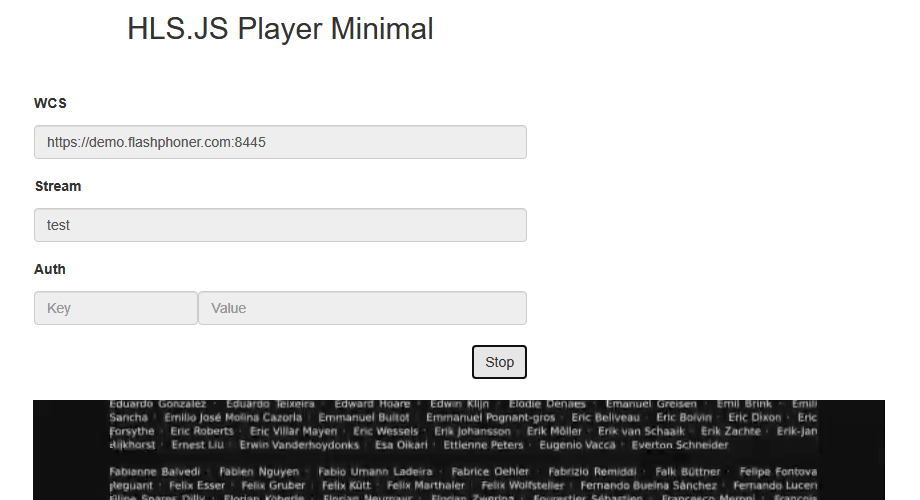...
| Table of Contents |
|---|
Example of stream convertion to HLS and playing it in browser
...
using HLS.js
The player shows how to convert stream published on WCS server to HLS and play it in browser. HLS stream cut starts automatically when strea is requested by HLS URL, for example httpsexample http://demo.flashphoner.com:8445localhost:8082/test/test.m3u8 on the screenshot below
The code of the example
The source code can be accessed on server by the following path:
...
Where host is WCS server address
Analyzing the code
...
To analize the code get hls-js-player.js file version with hash 51703a2 ecbadc3 which is available available here and and can be downloaded in build build 2.0.5.28.2753.141.212.
1. A server HLS URL detection
getHLSUrl() code
| Code Block | ||||
|---|---|---|---|---|
| ||||
function initPage() {
$("#header").text("HLS.JS Player Minimal");
$("#urlServer").val(getHLSUrl());
...
} |
2. div element set up to pass to the player
A div element for stream playback is passed to player
...
3. Stream name detection (the stream should be published to server)
encodeURIComponent() code
| Code Block | ||||
|---|---|---|---|---|
| ||||
function playBtnClick() {
if (validateForm()) {
var streamName = $('#playStream').val();
streamName = encodeURIComponent(streamName);
...
}
} |
4. HLS stream URL forming
If authentication key and token are set, they will be inclueded to stream URL
| Code Block | ||||
|---|---|---|---|---|
| ||||
function playBtnClick() {
if (validateForm()) {
...
var videoSrc = $("#urlServer").val() + '/' + streamName + '/' + streamName + '.m3u8';
var key = $('#key').val();
var token = $("#token").val();
if (key.length > 0 && token.length > 0) {
videoSrc += "?" + key + "=" + token;
}
...
}
} |
5. Player starting
If browser does not support MSE, player will not be started and a warning will be displayed
| Code Block | ||||
|---|---|---|---|---|
| ||||
function playBtnClick() {
if (validateForm()) {
...
if (Hls.isSupported()) {
console.log("Low Latency HLS: "+llHlsEnabled)
var hlshlsPlayer = new Hls(getHlsConfig(llHlsEnabled));
hlshlsPlayer.loadSource(videoSrc);
hlshlsPlayer.attachMedia(remoteVideo);
hlshlsPlayer.on(Hls.Events.MANIFEST_PARSED, function() {
console.log("Play with HLS.js");
remoteVideo.play();
onStarted();
});
}
else {
$("#notifyFlash").text("Your browser doesn't support MSE technology required to play video");
}
}
} |
6. Playback stopping
| Code Block | ||||
|---|---|---|---|---|
| ||||
function stopBtnClick() {
if (hlsPlayer != null) {
console.log("Stop HLS segments loading");
hlsPlayer.stopLoad();
hlsPlayer = null;
}
if (remoteVideo != null) {
console.log("Stop HTML5 player");
remoteVideo.pause();
remoteVideo.currentTime = 0;
remoteVideo.removeAttribute('src');
remoteVideo.load();
}
onStopped();
} |
7. HLS.js player configuration
| Code Block | ||||
|---|---|---|---|---|
| ||||
function getHlsConfig(llHlsEnabled) { var config = { lowLatencyMode: false, enableWorker: true, backBufferLength: 90 }; if(llHlsEnabled) { // Here we configure HLS.JS for lower latency config = { lowLatencyMode: llHlsEnabled, enableWorker: true, backBufferLength: 90, liveBackBufferLength: 0, liveSyncDuration: 0.5, liveMaxLatencyDuration: 5, liveDurationInfinity: true, highBufferWatchdogPeriod: 1, }; } return config; } |

